Directions (1–5): Study the following information carefully and answer the questions given below.
Seven persons P, Q, R, S, T, U and V like different colours Purple, Green, Yellow, Blue, White, Brown, and Black (not necessarily in same order) also they are from different cities. One of the persons from Delhi. Neither Q nor U likes yellow and brown colour. T likes white colour and is from Kolkata city. Q is from either Noida or Gurgaon. S doesn’t like purple and yellow colour. The one who is from Gurgaon city doesn’t like purple colour. P likes green colour. The one who likes black colour is not from Chennai city. S is from Chennai city. V is from Pune city. The person who is from Goa city likes brown colour. U is not from Noida city. P is not from Noida and Gurgaon city.
Q1. Who among the following likes Purple Colour?
(a) S
(b) R
(c) U
(d) Q
(e) V
Q2. Who among the following person is from Delhi city?
(a) Q
(b) R
(c) P
(d) S
(e) T
Q3. Which of the following combination is true about U?
(a) Black-Gurgaon
(b) Blue-Delhi
(c) Yellow-Kolkata
(d) Purple-Chennai
(e) Green-Noida
Q4. Which of the following combination is true?
(a) P- Goa
(b) R-Noida
(c) Q- Chennai
(d) U-Delhi
(e) S- Chennai
Q5- Who among the following person is from Goa?
(a) U
(b) R
(c) Q
(d) V
(e) None of these
Directions (6-10): In these questions, relationship between different elements is shown in the statements. The statements are followed by conclusions. Study the conclusions based on the given statements and select the appropriate answer. Give answer-
Q6.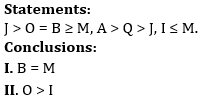
(a) If only conclusion I is true
(b) If only conclusion II is true
(c) If both conclusions I and II are true.
(d) If either conclusion I or II is true
(e) If neither conclusion I nor II is true.
Q7.
(a) If only conclusion I is true
(b) If only conclusion II is true
(c) If both conclusions I and II are true.
(d) If either conclusion I or II is true
(e) If neither conclusion I nor II is true.
Q8.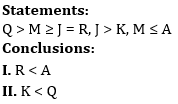
(a) If only conclusion I is true
(b) If only conclusion II is true
(c) If both conclusions I and II are true.
(d) If either conclusion I or II is true
(e) If neither conclusion I nor II is true.
Q9.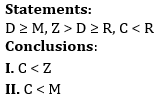
(a) If only conclusion I is true
(b) If only conclusion II is true
(c) If both conclusions I and II are true.
(d) If either conclusion I or II is true
(e) If neither conclusion I nor II is true.
Q10.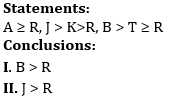
(a) If only conclusion I is true
(b) If only conclusion II is true
(c) If both conclusions I and II are true.
(d) If either conclusion I or II is true
(e) If neither conclusion I nor II is true.
Directions (11-15): In each of the following questions assuming the given statements to be true, find out which of the two conclusions I and II given below them is/are definitely true. Give answer
Q11.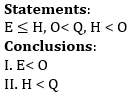
(a) if only conclusions I is true.
(b) if only conclusions II is true.
(c) if either conclusion I or conclusion II is true.
(d) if neither conclusion I nor conclusions II is true.
(e) if both conclusions I and II are true.
Q12.
(a) if only conclusions I is true.
(b) if only conclusions II is true.
(c) if either conclusion I or conclusion II is true.
(d) if neither conclusion I nor conclusions II is true.
(e) if both conclusions I and II are true.
Q13.
(a) if only conclusions I is true.
(b) if only conclusions II is true.
(c) if either conclusion I or conclusion II is true.
(d) if neither conclusion I nor conclusions II is true.
(e) if both conclusions I and II are true.
Q14.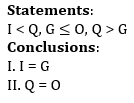
(a) if only conclusions I is true.
(b) if only conclusions II is true.
(c) if either conclusion I or conclusion II is true.
(d) if neither conclusion I nor conclusions II is true.
(e) if both conclusions I and II are true.
Q15.
(a) if only conclusions I is true.
(b) if only conclusions II is true.
(c) if either conclusion I or conclusion II is true.
(d) if neither conclusion I nor conclusions II is true.
(e) if both conclusions I and II are true.
Solutions
Solution (1-5):
Sol.
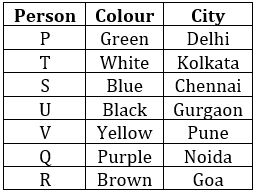
S1. Ans. (d)
S2. Ans. (c)
S3. Ans. (a)
S4. Ans. (e)
S5. Ans. (b)
S6. Ans. (e)
Sol. I. B = M(False)
II. O > I (False)
S7. Ans. (b)
Sol. I. S > R (False)
II. K < Z(True)
S8. Ans. (b)
Sol. I. R < A(False)
II. K < Q (True)
S9. Ans. (a)
Sol. I. C < Z (True)
II. C < M(False)
S10. Ans. (c)
Sol. I. B > R(True)
II. J > R(True)
S11. Ans. (e)
Sol.
S12. Ans. (b)
Sol.
S13. Ans. (a)
Sol.
S14. Ans. (d)
Sol.
S15. Ans.(a)
Sol.


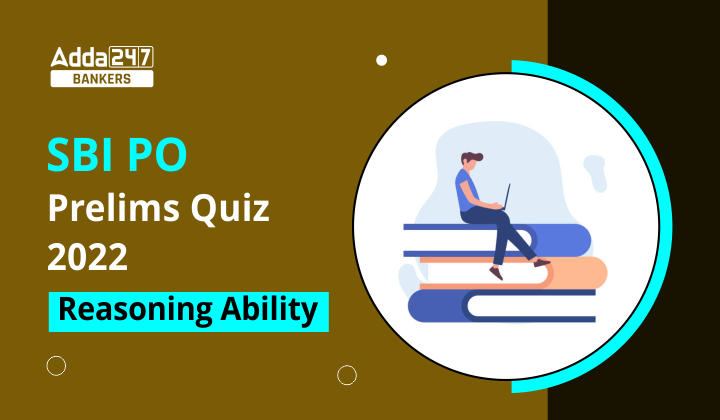


 GA Capsule for SBI Clerk Mains 2025, Dow...
GA Capsule for SBI Clerk Mains 2025, Dow...
 The Hindu Review October 2022: Download ...
The Hindu Review October 2022: Download ...
 AIC Management Trainee Syllabus and Exam...
AIC Management Trainee Syllabus and Exam...





